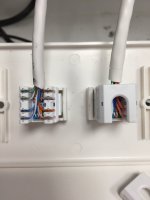You are using an out of date browser. It may not display this or other websites correctly.
You should upgrade or use an alternative browser.
You should upgrade or use an alternative browser.
Home Ethernet
- Thread starter charlie b
- Start date
Birken Vogt
Senior Member
- Location
- Grass Valley, Ca
If I am not mistaken, back when ports were not autosensing, we would make crossover cables A to B to reverse the TX and RX pairs. I would be surprised if that did not continue to this day. So it might not matter if you wired each end A or B, it would just autosense and adapt. Actually that must be the case because you can use any cable to connect between 2 devices these days, like if you have 2 switches next to each other in a rack and join them with whatever cable is handy.You are going to have to look at least one to see which standard the installer used (568A or B) before wiring the patch panel anyway. 568B is most common
hbiss
EC, Westchester, New York NEC: 2014
- Location
- Hawthorne, New York NEC: 2014
- Occupation
- EC
If you did, the wiremapper would show it as a miswire and it wouldn't pass.So it might not matter if you wired each end A or B,
-Hal
- Location
- Wisconsin
- Occupation
- PE (Retired) - Power Systems
The office I was in was wired as neither A or B. The contractor simply laid the wires directly to the plugs (no wires were crossed). All of the 'smart' switch ports and desk equipment got along just fine.568A or 568B are both fine...all you really need to do it make sure both sides of the cable are terminated the same and you will be fine
hbiss
EC, Westchester, New York NEC: 2014
- Location
- Hawthorne, New York NEC: 2014
- Occupation
- EC
He would have had to maintain the same order on both ends and didn't just "simply lay the wires" in some random way on each end. It may have worked, but now instead of CAT6 you have the speed of a CAT1 or CAT nothing.The office I was in was wired as neither A or B. The contractor simply laid the wires directly to the plugs (no wires were crossed). All of the 'smart' switch ports and desk equipment got along just fine.
Fine for email, I suppose.
-Hal
I had a co-worker do that. It was fine for 10baseT, but at gigabit speeds and long runs, you need to make sure the differential data lines are on a twisted pair, and not split across separate pairs. The twisted pairs exist for a reason.The office I was in was wired as neither A or B. The contractor simply laid the wires directly to the plugs (no wires were crossed). All of the 'smart' switch ports and desk equipment got along just fine.
- Location
- Wisconsin
- Occupation
- PE (Retired) - Power Systems
But very few "switch to desktop' ever need anything more than 10baseT. yeah there are exceptions, but those installers usually have a good handle on what is needed. People are willing to live with wireless performance, so even a wired Cat5 installation is usually acceptable.I had a co-worker do that. It was fine for 10baseT, but at gigabit speeds and long runs, you need to make sure the differential data lines are on a twisted pair, and not split across separate pairs. The twisted pairs exist for a reason.
In Charlies case here, I would bet that all of his 'in-wall' cables have nothing connected to them. My guess is his heavy network usage is probably streaming (1) 4K video at a time.
And of course,cables should be installed correctly, because the next person may actually want to be able use them.
hbiss
EC, Westchester, New York NEC: 2014
- Location
- Hawthorne, New York NEC: 2014
- Occupation
- EC
I mean geeze, didn't those guys think those colored labels on the jacks meant anything?I had a co-worker do that.
-Hal
He was putting male RJ45's on the end of the cable, so no colors to follow. At least he knew to do each end the same. Those would then either go directly into the computer or into a switch or patch panel feed thru. This was a room of software developers, and they can push things. Moving software builds around needed 100base T as soon as we could get it, and as soon as we could get gigabit they wanted it too. Made a significant different in time spent twiddling your thumbs.I mean geeze, didn't those guys think those colored labels on the jacks meant anything?
-Hal
Our building was gigabit while the building to building links were 100 baseT and company standard was 100 baseT inside a building. Then some bean counter said they wanted to consolidate the software repository to a central site not on our campus. We showed them how long our builds took when doing that and they backed off. Off site was even slower than 100 baseT and the router hops really killed performance.
LarryFine
Master Electrician Electric Contractor Richmond VA
- Location
- Henrico County, VA
- Occupation
- Electrical Contractor



